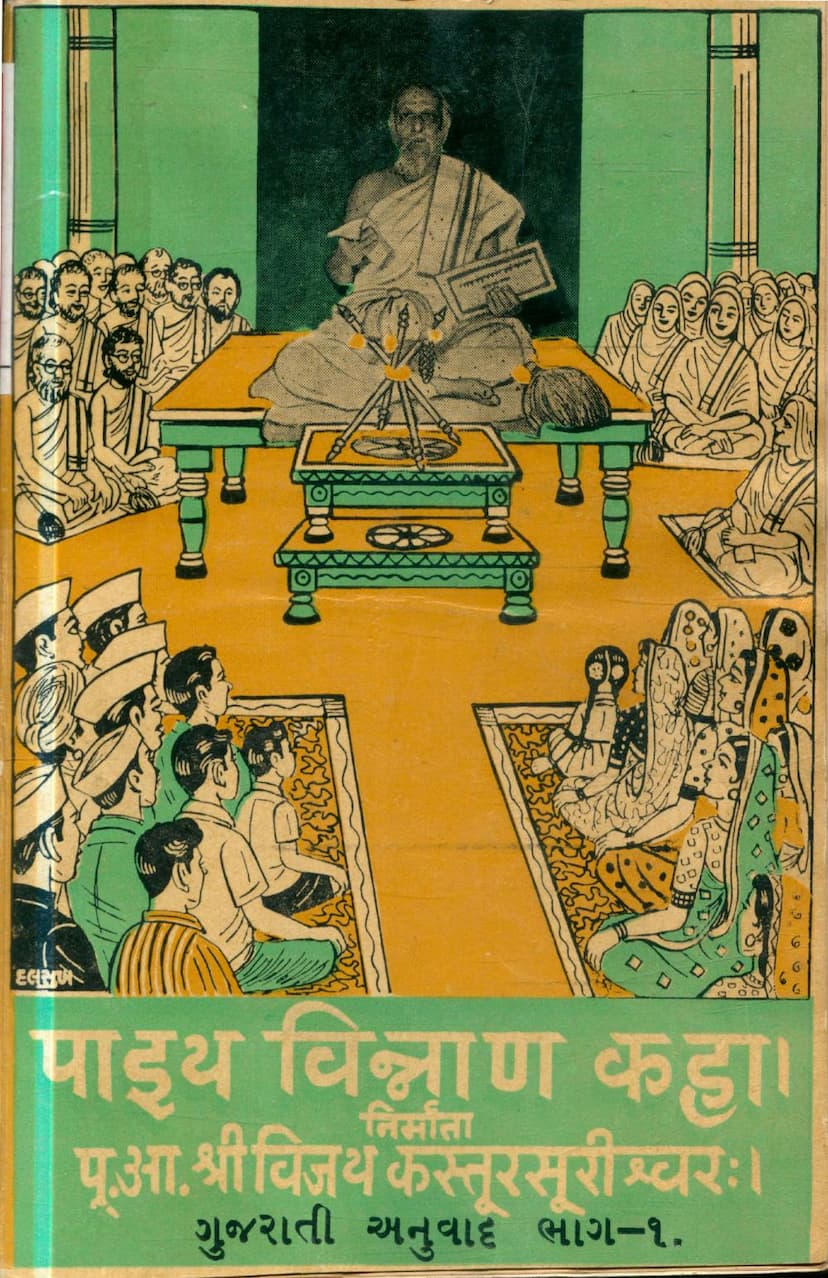Paia Vinnana Kaha Part 01
Added to library: September 2, 2025

Summary
The book "Paia Vinnana Kaha Part 01" (Prakrit Science Stories, Part 1) by Vijaykastursuri, published by Shri Vijay-Nemi-Vigyan-Kastursuri Gyanmandir, Surat, is the Gujarati translation of a work originally authored in Prakrit. This first part contains 55 stories.
The book is dedicated to the glory of Jainism and highlights the virtuous lives and spiritual endeavors of various Acharyas and monks within the Tapa Gachha lineage, particularly referencing Acharya Vijaynemisurishwarji Maharaj, Acharya Vijayvigyan Surishwarji Maharaj, and Acharya Vijaykastursuri.
The introductory pages (pages 5-28) provide a detailed chronological account of the significant religious and community activities that took place under the guidance of Acharya Shri Vijaykastursuri Maharaj and his lineage. These include:
- Religious Events and Festivals: The text meticulously documents various Chaturmas periods, the establishment and consecration of new Jin temples (Jinalay), statue consecrations (Pratishtha), installation ceremonies (Anjan Shalaka Mahotsav), and significant religious festivals like the Rath Yatra celebrating the 2500th Nirvana Kalyanak of Lord Mahavir.
- Acarya's Travels and Activities: The narrative follows the Acharya's journeys (vihar) across various locations in Gujarat, such as Sabarmati, Usmanpura (Ahmedabad), Surendranagar, Limbdi, Bhavnagar, and Mahuva. It details his spiritual guidance, public discourses, and the initiation of disciples.
- Community Development and Support: The text also touches upon community initiatives, including the establishment of educational institutions (Jain Shala), efforts to acquire ancient idols, and the active participation of the Jain community in these endeavors.
- Gurchh Activities: Specific events like the ordination of disciples (diksha), presentation of Acharya positions (Acharya Pad Pradan), and the celebration of significant anniversaries of revered Acharyas are highlighted, showcasing the vibrant religious and social life within the Jain community.
- End of an Era: The book also poignantly notes the passing of revered Acharyas, underscoring the cyclical nature of spiritual leadership and the continuity of the monastic tradition.
The main body of the book, starting from page 47, presents a collection of 55 Prakrit stories translated into Gujarati. These stories are designed to impart moral and spiritual lessons, often illustrated through allegorical narratives involving kings, ministers, merchants, common people, and even animals. The themes explored include:
- Virtue and Vice: Stories emphasize the importance of virtues like humility (Phalashali's story), truthfulness, kindness, and the detrimental consequences of vices like greed (Mamman Sheth's story), anger, lust, and arrogance.
- Consequences of Actions: Many narratives illustrate the principle of karma, showing how actions in past lives influence present circumstances and how righteous deeds lead to favorable outcomes, while unrighteous actions lead to suffering (e.g., Kalasaukarik's story, the story of the merchant who lost his wealth).
- Wisdom and Prudence: Stories highlight the value of intelligence, foresight, and sound judgment, often contrasting the actions of wise characters with those who are foolish or driven by emotion (e.g., the story of the old minister, the story of the king and the farmer).
- Devotion and Faith: The power of sincere devotion and faith, even from humble origins, is demonstrated (e.g., the story of the destitute woman and her devotion to Lord Mahavir).
- The Nature of Reality: Some stories touch upon philosophical concepts, such as the impermanence of worldly possessions and the illusory nature of sensory pleasures, encouraging detachment and spiritual pursuit.
- The Importance of Association: The impact of good company and the negative influence of bad company are also explored.
Each story is followed by a brief moral or "Upadesh" (lesson) that summarizes the key takeaway, encouraging the reader to apply these principles in their own lives. The overall aim of these stories is to educate and inspire readers, fostering a deeper understanding and practice of Jain ethical and spiritual teachings.